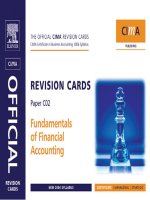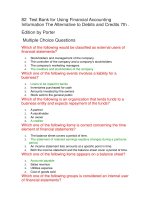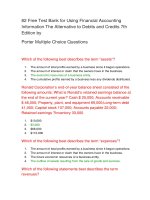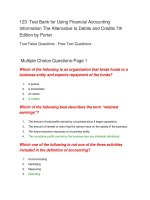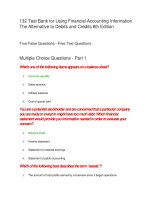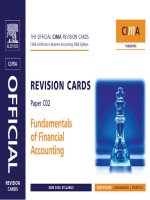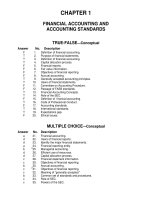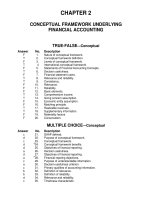Test bank fundamental of FInancial accounting 5th by philips
Bạn đang xem bản rút gọn của tài liệu. Xem và tải ngay bản đầy đủ của tài liệu tại đây (1.01 MB, 85 trang )
TEST BANK for Fundamentals of Financial Accounting 5th Edition by
Phillips
SOLUTIONS MANUAL for Fundamentals of Financial Accounting 5th
Edition by Phillips
TRUE/FALSE
[QUESTION]
1. A transaction is an exchange or event that directly affects the assets, liabilities, or
stockholders' equity of a company.
Answer: True
Difficulty: 1 Easy
LO: 02-01
Topic: Transactions and Other Activities
Blooms: Remember
AACSB: Analytic
AICPA BB: Resource Management
AICPA FN: Reporting
Feedback: A transaction is an event or activity that has a direct and measurable financial
effect on the assets, liabilities, or stockholders’ equity of a business.
[QUESTION]
2. General Motors (GM) signs a new labor agreement that its workers will receive a 5% wage
increase next year. This transaction affects GM's financial statements in the current year.
Answer: False
Difficulty: 2 Medium
LO: 02-01
Topic: Transactions and Other Activities
Blooms: Understand
AACSB: Analytic
AICPA BB: Critical Thinking
AICPA FN: Reporting
Feedback: A promise to pay has been exchanged for a promise to work next year. This
activity is not a transaction because no assets or services were exchanged at the time the new
labor agreement is signed. This event does not GM’s financial statements in the current year.
[QUESTION]
3. If total assets increase, then either total liabilities or total stockholders' equity must also
increase.
Answer: True
Difficulty: 1 Easy
LO: 02-02
Topic: Step 1: Analyze Transactions
Blooms: Understand
AACSB: Analytic
AICPA BB: Resource Management
AICPA FN: Reporting
Feedback: The accounting equation (Assets = Liabilities + Stockholders’ Equity) must
balance. If one side of the equation increases, the other side must increase.
[QUESTION]
4. A company signed an agreement to rent store space from another company. This is an
example of a transaction that should be recorded.
Answer: False
Difficulty: 1 Easy
LO: 02-01
Topic: Transactions and Other Activities
Blooms: Understand
AACSB: Analytic
AICPA BB: Resource Management
AICPA FN: Reporting
Feedback: This activity is not a transaction because no assets or services were exchanged at
the time the agreement was signed. This is not a transaction.
[QUESTION]
5. A business is obliged to repay both debt and equity financing.
Answer: False
Difficulty: 2 Medium
LO: 02-01
Topic: Building a Balance Sheet from Business Activities
Blooms: Remember
AACSB: Analytic
AICPA BB: Legal
AICPA FN: Reporting
Feedback: There is no requirement to pay back equity contributions to stockholders. There is
a legal requirement to pay back debt financing to creditors.
[QUESTION]
6. You are pleasantly surprised to discover that a popular actress appears on The Tonight
Show wearing your company's jeans. Later, your company's sales increase by $500,000 as a
result. When the actress appeared on TV, you would have recorded an asset because the TV
appearance was expected to bring future economic benefits to your company.
Answer: False
Difficulty: 3 Hard
LO: 02-01
Topic: Building a Balance Sheet from Business Activities
Blooms: Evaluate
AACSB: Reflective Thinking
AICPA BB: Critical Thinking
AICPA FN: Reporting
Feedback: This activity is not a transaction because no assets or services were exchanged at
the time the actress appeared on television. No asset would be recorded. In addition, recall
that an asset is an economic resource presently controlled by the company; it has measurable
value and is expected to benefit the company by producing cash inflows or reducing cash
outflows in the future. This situation does not meet the definition of an asset.
[QUESTION]
7. If a company uses $100 million of its cash to pay off debt, its stockholders' equity will
increase $100 million.
Answer: False
Difficulty: 2 Medium
LO: 02-02
Topic: Step 1: Analyze Transactions
Blooms: Understand
AACSB: Analytic
AICPA BB: Resource Management
AICPA FN: Reporting
Feedback: Assets and liabilities would each decrease by $100 million; there is no impact on
stockholders' equity.
[QUESTION]
8. Company X issues $40 million in new stock for cash. This does not affect stockholders'
equity because as new shares are sold, the value of existing shares falls.
Answer: False
Difficulty: 2 Medium
LO: 02-02
Topic: Step 1: Analyze Transactions
Blooms: Understand
AACSB: Analytic
AICPA BB: Resource Management
AICPA FN: Reporting
Feedback: When new stock is issued for cash, the company has more cash and common stock.
Assets and stockholders' equity both increase.
[QUESTION]
9. The analyze-record-summarize process is applied to daily transactions, to month-end
adjustments, and as part of the year-end closing process.
Answer: True
Difficulty: Medium
LO: 02-02
Topic: Steps 2 and 3: Record and Summarize
Blooms: Remember
AACSB: Analytic
AICPA BB: Legal
AICPA FN: Reporting
Feedback: The three-step analyze-record-summarize process is applied to daily transactions,
as well as adjustments at the end of each month, before preparing a trial balance and the
financial statements.
[QUESTION]
10. The list of account names and reference numbers that the company will use when
accounting for transactions is called the chart of accounts.
Answer: True
Difficulty: 1 Easy
LO: 02-02
Topic: Step 1: Analyze Transactions
Blooms: Remember
AACSB: Analytic
AICPA BB: Resource Management
AICPA FN: Reporting
Feedback: The chart of accounts is a summary of all account names (and corresponding
account numbers) used to record financial results in the accounting system.
[QUESTION]
11. A debit may increase or decrease an account, depending on the type of account.
Answer: True
Difficulty: 2 Medium
LO: 02-03
Topic: The Debit/Credit Framework
Blooms: Understand
AACSB: Analytic
AICPA BB: Resource Management
AICPA FN: Reporting
Feedback: Whether a debit or credit increases or decreases an account depends upon the type
of account. Debits increase assets, expenses, and dividends, but decrease liabilities, revenues,
and equity. Credits increase liabilities, revenue, and equity, but decrease assets, expenses and
dividends.
[QUESTION]
12. The normal balance of an account is on the same side that increases the account.
Answer: True
Difficulty: 1 Easy
LO: 02-03
Topic: The Debit/Credit Framework
Blooms: Remember
AACSB: Analytic
AICPA BB: Resource Management
AICPA FN: Reporting
Feedback: The balance in an account is determined by the excess of increases over decreases.
It is normal to have more increases in an account than decreases.
[QUESTION]
13. If the total dollar value of credits to an account exceeds the total dollar value of debits to
that account, the ending balance of the account will be a debit balance.
Answer: False
Difficulty: 1 Easy
LO: 02-03
Topic: The Debit/Credit Framework
Blooms: Understand
AACSB: Analytic
AICPA BB: Resource Management
AICPA FN: Reporting
Feedback: If credits exceed debits, the account will have a credit balance.
[QUESTION]
14. Every transaction increases at least one account and decreases at least one account.
Answer: False
Difficulty: 2 Medium
LO: 02-03
Topic: The Debit/Credit Framework
Blooms: Understand
AACSB: Analytic
AICPA B: Resource Management
AICPA FN: Reporting
Feedback: A transaction may have any combination of increases and decreases. For example,
a purchase of equipment on account increases both equipment and accounts payable. What is
true is that every transaction is recorded with at least one debit and at least one credit.
[QUESTION]
15. Accounts increase on the same side as they appear in the accounting equation: A = L +
SE.
Answer: True
Difficulty: Easy
LO: 02-03
Topic: The Debit/Credit Framework
Blooms: Remember
AACSB: Analytic
AICPA BB: Resource Management
AICPA FN: Reporting
Feedback: Accounts on the left side of the accounting equation (that is, assets) increase on the
left side and accounts on the right side of the equation (that is, liabilities and stockholders’
equity) increase on the right side.
[QUESTION]
16. Journal entries show the effects of transactions on the elements of the accounting
equation, as well as the account balances.
Answer: False
Difficulty: 2 Medium
LO: 02-03
Topic: The Debit/Credit Framework
Blooms: Understand
AACSB: Analytic
AICPA BB: Resource Management
AICPA FN: Reporting
Feedback: Journal entries are entered into the journal using a debit/credit format. By
themselves, journal entries show the effect of transactions, but they do not provide account
balances. The entries are “posted” to the ledger accounts, which then show the balance of
each of the accounts.
[QUESTION]
17. The general ledger is an internal report that lists all the accounts and their balances and is
used to check that total debits equals total credits.
Answer: False
Difficulty: 2 Medium
LO: 02-04
Topic: Preparing a Trial Balance and Balance Sheet
Blooms: Understand
AACSB: Reflective Thinking
AICPA BB: Critical Thinking
AICPA FN: Reporting
Feedback: The trial balance is an internal report that lists all the accounts and their balances
and is used to check that total debits equals total credits.
[QUESTION]
18. A classified balance sheet shows a subtotal for current assets and current liabilities.
Answer: True
Difficulty: 1 Easy
LO: 02-04
Topic: Preparing a Trial Balance and Balance Sheet
Blooms: Understand
AACSB: Reflective Thinking
AICPA BB: Critical Thinking
AICPA FN: Reporting
Feedback: A classified balance sheet contains subcategories and subtotals for current assets
and current liabilities.
[QUESTION]
19. When a company prepares a classified balance sheet, stockholders’ equity accounts must
be shown in subcategories of current and noncurrent.
Answer: False
Difficulty: 2 Medium
LO: 02-04
Topic: Preparing a Trial Balance and Balance Sheet
Blooms: Understand
AACSB: Reflective Thinking
AICPA BB: Critical Thinking
AICPA FN: Reporting
Feedback: Assets and liabilities are classified as current and noncurrent. Stockholders’ equity
accounts are not classified as current or noncurrent.
[QUESTION]
20. The trial balance is a financial statement that reports the assets, liabilities, and equity of a
business at a point in time.
Answer: False
Difficulty: 1 Easy
LO: 02-03
LO: 02-04
Topic: The Debit/Credit Framework
Topic: Preparing a Trial Balance and Balance Sheet
Blooms: Remember
AACSB: Analytic
AICPA BB: Resource Management
AICPA FN: Reporting
Feedback: The trial balance is an internal accounting report that lists the balances in all the
ledger accounts at a point in time. It shows whether debit balance accounts equal the credit
balance accounts. A balance sheet is a financial statement that reports the assets, liabilities,
and equity of a business at a point in time.
[QUESTION]
21. The acquisition of equipment in an exchange for a company’s stock would increase the
current ratio of the company.
Answer: False
Difficulty: 2 Medium
LO: 02-05
Topic: Assessing the Ability to Pay
Blooms: Analyze
AACSB: Analytic
AICPA BB: Resource Management
AICPA FN: Reporting
Feedback: The current ratio is current assets divided by current liabilities. Neither of the
accounts in this transaction would be classified as current and, so, this transaction does not
affect the current ratio.
[QUESTION]
22. The current ratio can be used to evaluate a company’s ability to pay liabilities in the short
term, and in general, a lower ratio means better ability to pay.
Answer: False
Difficulty: 2 Medium
LO: 02-05
Topic: Assessing the Ability to Pay
Blooms: Understand
AACSB: Analytic
AICPA BB: Resource Management
AICPA FN: Reporting
Feedback: The current ratio is current assets divided by current liabilities. A higher ratio
means better ability to pay.
MULTIPLE CHOICE
[QUESTION]
23. Owners of a company:
A) hold promissory notes as evidence of their ownership claim.
B) are entitled to repayment of their investment.
C) have a claim that is secondary to creditor’s claims.
D) have a claim equal to the amount of liabilities a company owes.
Answer: C
Difficulty: 3 Hard
LO: 02-01
Topic: Building a Balance Sheet from Business Activities
Blooms: Understand
AACSB: Analytic
AICPA BB: Resource Management
AICPA FN: Reporting
Feedback: Owners have a claim on company assets that is secondary to creditor’s claims.
Promissory notes are the legal documents that describe the details of a loan; stock certificates
are evidence of ownership claims. A business is obligated to repay debt financing, but is not
obligated to repay equity financing. Creditors have a claim on company assets equal to the
amount of liabilities that the company owes.
[QUESTION]
24. If a company borrows money from a bank and signs an agreement to repay the loan
several years from now, in which account would the company report the amount borrowed?
A) Common Stock
B) Accounts Payable
C) Notes Payable (long-term)
D) Retained Earnings
Answer: C
Difficulty: 2 Medium
LO: 02-01
Topic: Building a Balance Sheet from Business Activities
Blooms: Understand
AACSB: Analytic
AICPA BB: Resource Management
AICPA FN: Reporting
Feedback: Debt financing refers to money obtained through loans. A formal loan with the
bank is reported as Notes Payable (long-term).
[QUESTION]
25. The Sweet Smell of Success Fragrance Company borrowed $60,000 from the bank to be
paid back in five years and used all of the money to purchase land for a new store. Sweet
Smell's balance sheet would show this as:
A) $60,000 under Land and $60,000 under Notes Payable (long-term).
B) $60,000 under Depreciation Expense and $60,000 under Notes Payable (long-term).
C) $60,000 under Land and $60,000 under Notes Receivable (long-term).
D) $60,000 under Other Assets and $60,000 under Other Liabilities.
Answer: A
Difficulty: 2 Medium
LO: 02-01
Topic: Building a Balance Sheet from Business Activities
Blooms: Understand
AACSB: Analytic
AICPA BB: Resource Management
AICPA FN: Measurement
Feedback: The purchase of land is recorded in the Land account and a noncurrent bank loan is
recorded as Notes Payable (long-term).
[QUESTION]
26. Transactions include which two types of events?
A) Direct events, indirect events
B) Monetary events, production events
C) External exchanges, internal events
D) Past events, future events
Answer: C
Difficulty: 1 Easy
LO: 02-01
Topic: Transactions and Other Activities
Blooms: Remember
AACSB: Analytic
AICPA BB: Resource Management
AICPA FN: Measurement
Feedback: Transactions include two types of events: external exchanges and internal events.
[QUESTION]
27. Your company places an order with suppliers for inventory for delivery in two weeks.
A) This is an internal event and it does not affect the balance sheet.
B) This is an activity that does not affect the balance sheet.
C) This is an internal event that affects the balance sheet.
D) This is an external exchange and it affects the balance sheet.
Answer: B
Difficulty: 2 Medium
LO: 02-01
Topic: Transactions and Other Activities
Blooms: Understand
AACSB: Analytic
AICPA BB: Resource Management
AICPA FN: Reporting
Feedback: External exchanges are exchanges involving assets, liabilities, and/or stockholders’
equity between the company and someone else. An order has been placed; but the promise to
pay will not occur until the supplies are delivered. An exchange of only promises is not an
accounting transaction. Since no exchange has occurred, this activity would not be recorded
as a transaction.
[QUESTION]
28. The characteristic shared by all liabilities is that they:
A) provide a future economic benefit.
B) result in an inflow of resources to the company.
C) always end in the word “payable.”
D) obligate the company to do something in the future.
Answer: D
Difficulty: 2 Medium
LO: 02-01
Topic: Building a Balance Sheet from Business Activities
Blooms: Remember
AACSB: Analytic
AICPA BB: Resource Management
AICPA FN: Reporting
Feedback: Liabilities are debts and other obligations that must be paid or settled in the future.
Not all liabilities have the word “payable” in their names.
[QUESTION]
29. Which of the following is a financing activity?
A) The business receives land and gives a check for $1,000.
B) The business receives $1,000 cash and in exchange gives a promissory note.
C) The business promises to hire an employee on the 15th of the month.
D) The business orders supplies and promises to pay for them at the end of the month.
Answer: B
Difficulty: 2 Medium
LO: 02-01
Topic: Building a Balance Sheet from Business Activities
Blooms: Understand
AACSB: Analytic
AICPA BB: Resource Management
AICPA FN: Reporting
Feedback: Financing activities involve debt transactions with lenders (e.g., Notes Payable) or
equity transactions with investors (e.g., Common Stock). Receiving cash in exchange for a
promissory note is a financing activity.
[QUESTION]
30. Which of the following would not be recorded as an accounting transaction?
A) Putting a deposit down on a new vehicle
B) Hiring a new employee
C) Receiving cash upon signing a note
D) Receiving a deposit from a customer
Answer: B
Difficulty: 2 Medium
LO: 02-01
Topic: Transactions and Other Activities
Blooms: Understand
AACSB: Analytic
AICPA BB: Resource Management
AICPA FN: Reporting
Feedback: A transaction is an event or activity that has a direct and measurable financial
effect on the assets, liabilities, or stockholders’ equity of a business. Hiring a new employee is
an activity that is not a transaction because no assets or services were exchanged at the time
the employee was hired.
[QUESTION]
31. The Flynn Company started business by obtaining financing through debt financing and
equity financing. Which of the following statements is not correct?
A) Equity financing refers to the money obtained through owners’ contributions and
reinvestments of profit.
B) Debt financing refers to the money obtained through loans.
C) The business is obligated to repay debt financing.
D) The business is obligated to repay equity financing.
Answer: D
Difficulty: 1 Easy
LO: 02-01
Topic: Building a Balance Sheet from Business Activities
Blooms: Remember
AACSB: Analytic
AICPA BB: Legal
AICPA FN: Measurement
Feedback: Equity refers to financing a business through owners’ contributions and
reinvestments of profit. Debt refers to financing the business through loans. A business is
obligated to repay debt financing, but it is not obligated to repay its equity financing.
[QUESTION]
32. Which of the following is not an asset?
A) Cash
B) Notes Receivable
C) Common Stock
D) Land
Answer: C
Difficulty: 1 Easy
LO: 02-01
Topic: Building a Balance Sheet from Business Activities
Blooms: Understand
AACSB: Analytic
AICPA BB: Resource Management
AICPA FN: Reporting
Feedback: Assets are resources presently owned by a business that generate future economic
benefits.. Cash, Notes Receivable, and Land are all examples of assets.
[QUESTION]
33. Which of the following would be treated as an accounting transaction for a gardening
supply store?
A) The company signed an agreement to rent store space at $200 month.
B) The vice president of the company spoke at a luncheon that contributed to enhancing the
company’s reputation as a responsible company.
C) The company ordered supplies for $500.
D) The company loaned $500 to an employee.
Answer: D
Difficulty: 2 Medium
LO: 02-01
Topic: Transactions and Other Activities
Blooms: Understand
AACSB: Analytic
AICPA BB: Resource Management
AICPA FN: Measurement
Feedback: A transaction is an event or activity that has a direct and measurable financial
effect on the assets, liabilities, or stockholders’ equity of a business. An asset (the employee’s
promise to pay) was exchanged for another asset (the cash given to the employee) and, so,
loaning $500 to an employee is a transaction. No exchange took place with regards to the
rental agreement, the speech, or the supply order.
[QUESTION]
34.
are of special importance because they are the only activities that
enter the financial accounting system.
A) External exchanges
B) Internal events
C) Documents
D) Transactions
Answer: D
Difficulty: 2 Medium
LO: 02-01
Topic: Transactions and Other Activities
Blooms: Understand
AACSB: Analytic
AICPA BB: Resource Management
AICPA FN: Reporting
Feedback: Business activities that affect the basic accounting equation (A 5 L 1 SE) are called
transactions. Transactions are of special importance because they are the only activities that
enter the financial accounting system.
[QUESTION]
35. A company has $26,000 in its Land account, $10,000 in its Inventory account, and $6,000
in its Notes Payable (short-term) account. If its only other account is Common Stock, what is
the balance of that account?
A) $10,000.
B) $42,000.
C) $30,000.
D) $22,000.
Answer: C
Difficulty: 2 Medium
LO: 02-02
Topic: Step 1: Analyze Transactions
Blooms: Apply
AACSB: Analytic
AICPA BB: Resource Management
AICPA FN: Reporting
Feedback:
Assets = Liabilities + Stockholders’ Equity
Stockholders’ Equity = Assets – Liabilities
= ($26,000 + $10,000) – $6,000 = $30,000
[QUESTION]
36. Stockholders’ equity in a corporation consists of:
A) Amounts invested and reinvested by a company’s owners.
B) Resources presently owned by a business that generate future economic benefits.
C) Amounts invested in assets that will be used for one or more years.
D) Amounts presently owed by a business.
Answer: A
Difficulty: 1 Easy
LO: 02-01
Topic: Building a Balance Sheet from Business Activities
Blooms: Remember
AACSB: Analytic
AICPA BB: Resource Management
AICPA FN: Reporting
Feedback: Stockholders’ equity is the amount invested and reinvested in a company by its
stockholders.
[QUESTION]
37. Typical cash flows from investing activities include:
A) payments to purchase property and equipment.
B) repayment of loans.
C) proceeds from issuing notes payable.
D) receipts from cash sales.
Answer: A
Difficulty: 2 Medium
LO: 02-01
Topic: Building a Balance Sheet from Business Activities
Blooms: Understand
AACSB: Analytic
AICPA BB: Resource Management
AICPA FN: Reporting
Feedback: Investing activities include buying or selling noncurrent assets, such as property
and equipment.
[QUESTION]
38. The requirement that transactions be recorded at their exchange price at the transaction
date is called the:
A)
B)
C)
D)
conservatism exception.
separate entity assumption.
cost principle.
monetary unit assumption.
Answer: C
Difficulty: 1 Easy
LO: 02-01
LO: 02-05
Topic: Building a Balance Sheet from Business Activities
Topic: Balance Sheet Concepts and Values
Blooms: Remember
AACSB: Analytic
AICPA BB: Resource Management
AICPA FN: Measurement
Feedback: The cost principle states that assets and liabilities should be initially recorded at
their original cost to the company. Following the cost principle, assets and liabilities are first
recorded at cost, which is their cash-equivalent value on the date of the transaction.
[QUESTION]
39. Which of the following is not an accounting transaction?
A) Issued shares of stock to investors in exchange for cash contributions of $4,000.
B) Ordered inventory from suppliers for $3,000.
C) Sold equipment to another company for $3,000 and accepted a note from the company
promising payment in 6 months.
D) Borrowed money from the bank by signing a promissory note for $2,000.
Answer: B
Difficulty: 1 Easy
LO: 02-02
Topic: Step 1: Analyze Transactions
Blooms: Understand
AACSB: Analytic
AICPA BB: Resource management
AICPA FN: Measurement
Feedback: External exchanges are exchanges involving assets, liabilities, and/or stockholders’
equity between the company and someone else. An exchange of only promises is not an
accounting transaction. Since no exchange has occurred when inventory is ordered from
suppliers, this activity would not be recorded as a transaction.
[QUESTION]
40. Account titles in the chart of accounts are:
A) general purpose and do not indicate the nature of the account.
B) consistent with those used by other companies.
C) linked to account numbers.
D) the names mandated for use by the FASB.
Answer: C
Difficulty: 2 Medium
LO: 02-02
Topic: Step 1: Analyze Transactions
Blooms: Remember
AACSB: Analytic
AICPA BB: Resource Management
AICPA FN: Reporting
Feedback: As part of transaction analysis, a name is given to each item exchanged.
Accountants refer to these names as account titles (or names). To ensure account titles are
used consistently, every company establishes a chart of accounts —a list that designates a
name and reference number that the company will use when accounting for each item it
exchanges. The chart of accounts is tailored to each company’s business, so although some
account titles are common across all companies, others may be unique to a particular
company.
[QUESTION]
41. Every transaction:
A) increases one account and decreases another account.
B) has at least two effects on the basic accounting equation.
C) affects only balance sheet accounts or only income statement accounts.
D) is analyzed from the standpoint of the business owners.
Answer: B
Difficulty: 3 Hard
LO: 02-02
Topic: Step 1: Analyze Transactions
Blooms: Understand
AACSB: Analytic
AICPA BB: Critical Thinking
AICPA FN: Reporting
Feedback: Every transaction has at least two effects on the basic accounting equation (at least
one debit and one credit). A transaction can result in two accounts increasing, two accounts
decreasing, or one account increasing and one account decreasing. A transaction may affect
two balance sheet accounts, two income statement accounts, or one of each. Every transaction
is analyzed from the standpoint of the business, not the owners.
[QUESTION]
42. The Buddy Burger Corporation owes $1.5 million to the Texas Wholesale Meat Company
from whom Buddy Burger buys its burger meat. Which account would Buddy Burger use to
report the amount owed?
A) Cash
B) Accounts Payable
C) Notes Payable
D) Accounts Receivable
Answer: B
Difficulty: 2 Medium
LO: 02-02
Topic: Step 1: Analyze Transactions
Blooms: Understand
AACSB: Analytic
AICPA BB: Resource Management
AICPA FN: Reporting
Feedback: Accounts Payable is used to report amounts owed to suppliers for goods or services
bought on credit (or on account).
[QUESTION]
43. If a company receives $20,000 cash from its customers on account and uses the cash to
pay $20,000 to its suppliers on accounts, the net result is that:
A) assets would increase by $20,000 while liabilities would decrease by $20,000.
B) liabilities would decrease by $20,000 while stockholders' equity would increase by
$20,000.
C) assets would decrease by $20,000 and liabilities would decrease by $20,000.
D) liabilities would decrease by $20,000 and stockholders' equity would decrease by $20,000.
Answer: C
Difficulty: 3 Hard
LO: 02-02
Topic: Step 1: Analyze Transactions
Blooms: Understand
AACSB: Analytic
AICPA BB: Resource Management
AICPA FN: Measurement
Feedback: Receiving cash of $20,000 from customers in payment of their accounts will cause
one asset (Cash) to increase and another asset (Accounts Receivable) to decrease. There is no
change in the amount of total assets. Using the $20,000 of cash received to pay off accounts
payable will cause an asset (Cash) to decrease and a liability (Accounts Payable) to decrease.
Considering both transactions, assets (Accounts Receivable) decrease by $20,000 and
liabilities (Accounts Payable) decrease by $20,000.
[QUESTION]
44. What is the minimum number of accounts that must be involved in any transaction?
A) One
B) Two
C) Three
D) There is no minimum.
Answer: B
Difficulty: 1 Easy
LO: 02-02
Topic: Step 1: Analyze Transactions
Blooms: Remember
AACSB: Analytic
AICPA BB: Resource Management
AICPA FN: Measurement
Feedback: Every transaction has at least two effects on the basic accounting equation.
[QUESTION]
45. Which of the following applies to Accounts Payable?
A) They can be outstanding for more than one year.
B) They charge interest.
C) It is an amount a business is obligated to repay.
D) They are documented using formal documents.
Answer: C
Difficulty: 2 Medium
LO: 02-02
Topic: Step 1: Analyze Transactions
Blooms: Understand
AACSB: Analytic
AICPA BB: Resource Management
AICPA FN: Reporting
Feedback: Accounts Payable is used to report amounts owed to suppliers for goods or services
bought on credit (or on account).
[QUESTION]
46. In part, a transaction affects the accounting equation by decreasing an asset. There is no
effect on liabilities. Which of the following statements is correct with regards to this
transaction?
A) If other assets are unchanged, stockholders' equity must be increasing.
B) If other assets are unchanged, stockholders' equity must be decreasing.
C) If stockholders' equity is unchanged, another asset must be decreasing.
D) If stockholders' equity is unchanged, other assets must be unchanged.
Answer: B
Difficulty: 1 Easy
LO: 02-02
Topic: Step 1: Analyze Transactions
Blooms: Understand
AACSB: Analytic
AICPA BB: Resource Management
AICPA FN: Reporting
Feedback: Change in assets = change in liabilities + change in stockholders’ equity. If assets
decrease and there is no change in liabilities, then either another asset must increase or
stockholders’ equity must decrease.
[QUESTION]
47. Your company pays back $2 million on a loan it had obtained earlier from a bank.
A) Assets decrease by $2 million; liabilities and stockholders' equity are both unchanged.
B) Assets decrease by $2 million, liabilities decrease by $2 million, and stockholders' equity
is unchanged.
C) Assets decrease by $2 million and liabilities increase by $2 million.
D) Assets decrease by $2 million, liabilities are unchanged, and stockholders’ equity
decreases by $2 million.
Answer: B
Difficulty: 2 Medium
LO: 02-02
Topic: Step 1: Analyze Transactions
Blooms: Understand
AACSB: Analytic
AICPA BB: Resource Management
AICPA FN: Reporting
Feedback: This transaction will cause assets (Cash) to decrease and liabilities (Notes Payable)
to decrease.
[QUESTION]
48. A company issues $20 million in new stock. It later uses the cash received to pay off
promissory notes. What accounts are affected by these two transactions?
A) Common Stock, Cash, and Notes Payable.
B) Common Stock, Cash, Investments, and Notes Payable.
C) Cash, Common Stock, and Accounts Payable.
D) Common Stock, Investments, and Notes Payable.
Answer: A
Difficulty: 2 Medium
LO: 02-02
Chapter 2: The Balance Sheet
Topic: Step 1: Analyze Transactions
Blooms: Understand
AACSB: Analytic
AICPA BB: Resource Management
AICPA FN: Reporting
Feedback: Issuing stock for cash means that Cash and Common Stock are affected. Using the
cash to pay off notes means that Cash and Notes Payable are affected.
[QUESTION]
49. A company borrows $2 million from its bank. It then uses this money to buy equipment.
How do these two transactions affect the company’s accounting equation?
A) Assets and liabilities both increase by $2 million.
B) Assets increase by $2 million and liabilities decrease by $2 million.
C) Assets increase by $4 million, liabilities increase by $2 million, and stockholders’ equity
increases by $2 million.
D) Assets remain unchanged and liabilities increase by $2 million.
Answer: A
Difficulty: 2 Medium
LO: 02-02
Topic: Step 1: Analyze Transactions
Blooms: Understand
AACSB: Analytic
AICPA BB: Resource Management
AICPA FN: Reporting
Feedback: The first transaction increases assets (Cash) and liabilities (Notes Payable). The
second transaction increases assets (Equipment) and decreases an asset (Cash). The Cash
account is increased and decreased by equal amounts. As such, taken together, these two
transactions increase assets (Equipment) and increase liabilities (Notes Payable).
[QUESTION]
50. A company receives $100,000 cash from investors in exchange for stock. Several weeks
later, the company buys a $250,000 machine using all of the cash from the stock issue and
signing a promissory note for the remainder. The accounts involved in these two transactions
are:
A) Cash; Equipment; Noncurrent Investments; and Accounts Payable.
B) Cash; Noncurrent Investments; Common Stock; and Notes Payable.
C) Cash; Equipment; Common Stock; and Notes Payable.
D) Equipment; Notes Payable; and Retained Earnings.
Answer: C
Difficulty: 2 Medium
LO: 02-02
Test Bank—Fundamentals of Financial Accounting, 5e
Copyright © 2016 McGraw-Hill Education. All rights reserved. No reproduction or distribution without the prior written consent of
McGraw-Hill Education.
21
Chapter 2: The Balance Sheet
Topic: Step 1: Analyze Transactions
Blooms: Understand
AACSB: Analytic
AICPA BB: Resource Management
AICPA FN: Reporting
Feedback: Receiving cash in exchange for common stock affects the Cash and Common
Stock accounts. Buying a machine using cash for part of the purchase amount and borrowing
the rest affects the Equipment, Cash, and Notes Payable accounts.
[QUESTION]
51. If total liabilities decreased by $25,000 and stockholders' equity increased by $5,000
during a period of time, then total assets must change by what amount and direction during
the same time period?
A) $20,000 increase
B) $20,000 decrease
C) $30,000 increase
D) $30,000 decrease
Answer: B
Difficulty: 1 Easy
LO: 02-02
Topic: Step 1: Analyze Transactions
Blooms: Understand
AACSB: Analytic
AICPA BB: Resource Management
AICPA FN: Reporting
Feedback:
Change in assets = Change in liabilities + Change in stockholders’ equity
= ($25,000) + $5,000 = ($20,000)
[QUESTION]
52. A company issues $20 million in new stock. The company later uses this money to
acquire a building. What is the effect of these two transactions on the company’s accounts?
A) Buildings increases and Common Stock increases.
B) Buildings increases and Common Stock decreases.
C) Cash increases, Buildings increases, and Common Stock increases.
D) Cash decreases, Buildings increases, and Common Stock decreases.
Answer: A
Difficulty: 2 Medium
LO: 02-02
Topic: Step 1: Analyze Transactions
Blooms: Understand
Test Bank—Fundamentals of Financial Accounting, 5e
Copyright © 2016 McGraw-Hill Education. All rights reserved. No reproduction or distribution without the prior written consent of
McGraw-Hill Education.
22
Chapter 2: The Balance Sheet
AACSB: Analytic
AICPA BB: Resource Management
AICPA FN: Reporting
Feedback: Receiving cash from the issuance of stock increases both Cash and Common
Stock. Using the cash to acquire a building causes the Cash account to decrease and the
Buildings account to increase. The Cash account is increased and decreased by equal
amounts. As such, taken together, these two transactions increase the Buildings account and
increase the Common Stock account.
[QUESTION]
53. Park & Company was recently formed with a $5,000 investment in the company by
stockholders in exchange for common stock. The company then borrowed $2,000 from a local
bank, purchased $1,000 of supplies on account, and also purchased $5,000 of equipment by
paying $2,000 in cash and signing a promissory note for the balance. Based on these
transactions, the company's total assets are:
A) $7,000.
B) $9,000.
C) $10,000.
D) $11,000.
Answer: D
Difficulty: 3 Hard
LO: 02-02
Topic: Step 1: Analyze Transactions
Blooms: Apply
AACSB: Analytic
AICPA BB: Resource Management
AICPA FN: Reporting
Feedback:
Cash of $5,000 cash from stock issuance + Cash of $2,000 borrowed from bank + Supplies
purchased in the amount of $1,000 + Equipment purchased in the amount of $5,000 – Cash
paid for equipment of $2,000 = $11,000
[QUESTION]
54. A company purchased land costing $27,000 by paying cash of $6,750 and signing a 90day note for the balance. The entry to record this transaction would:
A) increase total assets.
B) decrease total liabilities.
C) decrease Common Stock.
D) increase total assets and decrease total liabilities.
Answer: A
Difficulty: 2 Medium
Chapter 2: The Balance Sheet
LO: 02-02
Topic: Step 1: Analyze Transactions
Blooms: Understand
AACSB: Analytic
AICPA BB: Resource Management
AICPA FN: Measurement
Feedback: The entry to record this transaction would increase Land by $27,000, decrease
Cash by $6,750, and increase Notes Payable by $20,250 (or $27,000 – $6,750).
[QUESTION]
55. On January 1, Kirk Corporation had total assets of $850,000. During the month, the
following activities occurred:
Kirk Corporation acquired equipment costing $6,000, promising to pay cash for it in 60
days.
Kirk Corporation purchased $3,500 of supplies for cash.
Kirk Corporation sold land which it had acquired 2 years ago. The land had cost $15,000
and it was sold for $15,000 cash.
Kirk Corporation signed an agreement to rent additional storage space next month at a
charge of $1,000 per month.
What is the amount of total assets of Kirk Corporation at the end of the month?
A) $859,500.
B) $856,000.
C) $837,500.
D) $840,000.
Answer: B
Difficulty: 3 Hard
LO: 02-02
Topic: Step 1: Analyze Transactions
Blooms: Analyze
AACSB: Analytic
AICPA BB: Resource Management
AICPA FN: Measurement
Feedback:
Beginning total assets of $850,000 + Equipment purchased of $6,000 + Supplies purchased of
$3,500 – Cash paid of $3,500 + Cash received from sale of land of $35,000 – Land sold of
$35,000 = $856,000
Signing a rental agreement is not an accounting transaction since there was no exchange
involving assets, liabilities, and/or stockholders’ equity between the company and someone
else.
[QUESTION]
56. When accounts receivable are collected:
